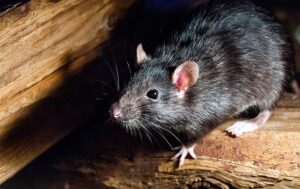Have you discovered traces of rodents or have you come across small, dark brown remains of feces? If so, you may have a rat infestation – but don’t worry, we’re here to help. If you suspect you may have a rat infestation, please call us now on 408-915-2172 to speak to our experts about our quick and effective rat treatments.

Rats are more active at night, so it’s often easier to spot the signs of a rat infestation than the rat itself. Below we’ve discussed some signs that could indicate you may have a rat problem.
- Rat Droppings – Brown Rat droppings are dark brown in a tapered, spindle shape – like a grain of rice.
- Rub Marks – Grease and dirt on their bodies leaves smudges on surfaces.
- Gnaw Marks – Black rats are agile climbers and often found in lofts. You might notice gnaw marks on wires, cabling or items stored in the loft .
- Rat Holes – Brown rats are well known for digging extensive burrow systems for shelter, food storage and nesting.
- Rat Nests – Rats will shred available materials such as loft insulation, cardboard and other soft items to make nests.
- Footprints – Rats leave foot and tail marks in dusty, less-used areas of buildings.
If you notice any of the above signs, we recommend you act quickly to prevent the potential infestation from spreading further.
What to Look for to Identify Signs of Rats
Rat Droppings
They are usually concentrated in certain places, as rats produce up to 40 poop per night. Brown rat feces are dark brown and shaped like a tapered spindle, resembling a large grain of rice.
Rub Marks
Because of their poor eyesight, rats use established paths along baseboards and walls. The grease and dirt on their bodies leaves dark stains and marks on objects and surfaces they repeatedly rub against.
Gnaw Marks
Black rats are agile climbers, which is why they are also called black rats. Wires, cables or other items with nail marks are often found in attics. Rats can be identified by the grinding noise they make with their teeth.
Rat Holes
Brown rats are known for digging and excavating extensive cave systems for shelter, food storage and nesting sites. They build rat dens next to solid objects or structures.
Rat Nests
Rats nest in caves, but rat nests can also be found in attics, under eaves and even in hollow walls. They shred available materials such as attic insulation, cardboard, and other soft objects to build nests.
Footprints
Rats leave paw and tail marks in dusty, less frequented areas of buildings. To determine if an infestation is active, sprinkle fine flour or talcum powder in the area near the prints and look for fresh spots the next day.
Where to check for Rats Inside
- Lofts & attic spaces -Look for shredded attic insulation, chewed objects, and rat droppings (rat droppings) in corners and in items like cardboard boxes.
- Kitchens & laundries – Look behind appliances like stoves, washing machines, dishwashers and dryers. Be sure to check areas where pipes or cables enter your property from the outside.
- Out of sight areas – and potentially unexpected places such as crawl spaces, suspended ceilings and even cavity walls can be infested with young rats.
Where to check for Rats Outside your property
Where in your home or business should you start looking for external signs of rats, their nests and the damage they can cause?
Rats are agile climbers that can jump, gnaw, and dig so realistically that you should check your property “top to bottom” and “inside and out.” Here are some common places where you might find evidence of a rat infestation:
- Decking – Check the edges of green areas for signs of damage from gnawing and burying. Below the deck is an area that rats often use for nesting.
- Sheds – Look for rat holes (cave entrances) around the edges of sheds and buildings. Rats like to burrow next to solid structures such as walls.
- Garages -Check door frames for gaps or eaten holes in the bottom of wooden doors. If you have a built-in garage, also check the interior door and any vents that might provide access to other interior areas.
- Compost bins – Compost piles attract rats because they are warm and contain food. Check the lid and bottom of the composter for holes and nail marks.
- Vegetation – Look for rat holes between the roots of trees and shrubs, in overgrown vegetation, or on nearby vacant lots.
- Drains – Check whether the drain covers are damaged or whether there are holes dug next to the drain covers.
Worried About Rats? Call Critter Control Of San Jose!
If you suspect you have rats, it is important to act quickly to control the extent of the infestation and reduce the health risks posed by these rodents. You can also take practical steps now to protect your home or business and prevent rats.
If you have a rat problem, please call us at Critter Control of San Jose at 1-800-CRITTER or 408-915-2172 in San Jose, Sunnyvale, Santa Clara, Milpitas and the Cupertino area.




